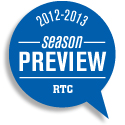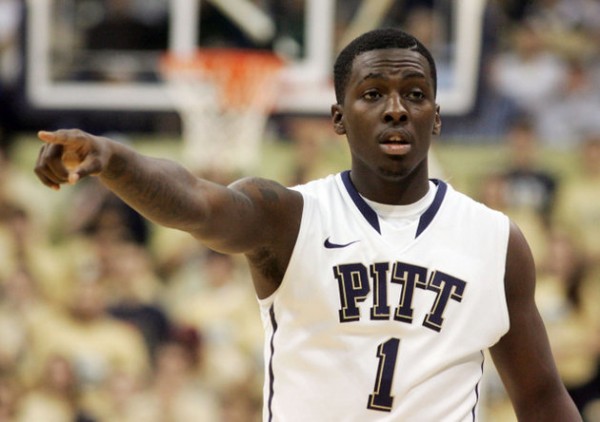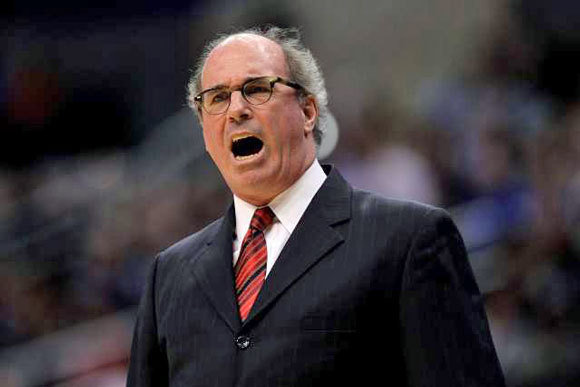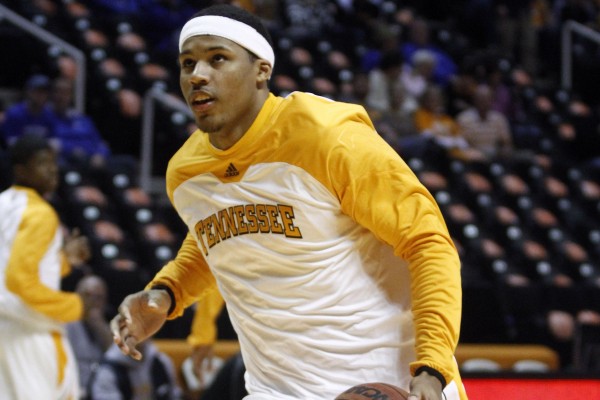Sizing Up Six Power Conference Teams Ready To Make the Leap
Posted by Chris Johnson on October 24th, 2012 Chris Johnson is an RTC Columnist. He can be reached @ChrisDJohnsonn.
Chris Johnson is an RTC Columnist. He can be reached @ChrisDJohnsonn.
College basketball, like most sports, is cyclical. Aside from the truly elite crop of blue-blooded programs, the Kentuckys and Dukes and Kansases and UNCs of the world, most teams are just as prone to have truly transcendent seasons as they are to crash and burn. Ok, that’s overstating the truth. I define these parameters in dramatic terms not as an accurate depiction of most teams’ year-to-year trajectories – it’s rare for a program to follow up a high-win season with an epic flameout – but to emphasize the fickle nature of the sport. We media types tend to overreact to single-season sample sizes, but in truth, most programs, whether through coaching changes, administrative shake-ups or otherwise, chart a steady long-term course. Teams suffer long downturns, sure, and some last longer than others. But most find ways (coaching changes, administrative shakeups, etc.) to right the ship, if only for one memorable season, to compete at the top of their respective leagues.

With a healthy Woodall, and a potential first-round talent in Adams, Pitt will regain its usual status among the Big East elite (Photo credit: US Presswire)
Underlying these trends is the inherent potential for random variance, for teams to break out of their expected competitive range and “make the leap.” It happens each and every season. Teams bounce back from particularly disappointing seasons to bump their win totals and challenge the same teams who oversaw their downfall one year prior. Predicting which teams are ready to fulfill that narrative is never easy. There are a variety of factors involved that make pinpointing breakout teams a fundamentally risky exercise. Sometimes conventional wisdom – decades-long concepts like returning starters directly correlating to success, or promising bench players seamlessly carrying their production rates into larger minute distributions and more shot attempts; you know, the ideas that never seem to play out the way you’d expect – does not apply to specific teams. Each situation is different, no matter what conventional logic you use to define a team’s potential.
To account for natural error, and the time-tested axiom that logical thinking does not prescribe college basketball teams to specific win ranges and milestones, I’ve selected six teams ready to make the aforementioned “leap,” one from each of the six power conferences. As a reminder, this exercise, like most any preseason preview article you’ll see on the web, is rooted mostly in opinion. No one’s actually seen these guys play real games together, at least not within the construct of this year’s team model. The knowledge base from which we make these predictions is limited – though larger and more permitting to some than others. We have observations from previous seasons, recruiting rankings, highlights and random hearsay from coaches and fans and whatnot, and that’s about it. Mistakes are likely, if not guaranteed. That said, each conference features a particularly salient breakout candidate, at least in my eyes. Let’s begin.
Big East – Pittsburgh
The way last season strayed from Pitt’s typically excellent season profile, projecting a return to the top of the Big East was arguably the easiest selection on this list. Under Jamie Dixon, the Panthers have grown into one of the nation’s most consistent programs. Last season was a fluke, and an utterly disappointing one at that. Still, expecting anything less than league title contention and a high NCAA Tournament seed in 2012 would be a severe underestimation of this team’s potential. Which is why I would be remiss to question their chances of returning to the top of the Big East. A reinvigorated and rehabilated Tray Woodall will handle the point guard position. Swingman Lamar Patterson offers perimeter scoring punch and aggressive defense at the point of attack. Talib Zanna and Dante Taylor will command major defensive attention on the low block, and you can expect they’ll bring the usual rebound-hungry tenacity Dixon demands of his frontcourt players. That’s a formidable lineup on it’s own. But the Panthers promise to be so, so much more, thanks mostly to a highly-touted recruiting class that features No. 4 ranked point guard James Robinson and No. 4-ranked center Steven Adams, per ESPN’s Recruiting nation. Adams will feature prominently in the Panthers’ frontcourt plans this season. Scouts say he’s raw offensively, but describe his rebounding and defensive skills in borderline hyperbolic terms. Adams can help Pitt revive the toughness and interior grit that’s defined its hoops identity during Dixon’s tenure. As the Panthers prepare to leave the ACC, they will leave the Big East with a glowing snapshot of Pittsburgh basketball, and in the process erase the negativity of last year’s campaign.
Big Ten – Iowa
Winning at Iowa, like so many other football-oriented schools, is not easy. It requires determination and creative recruiting tactics. Coaches need to invent ways to generate administrative and fan support, to convince the program and the larger academic community that the season does indeed begin before February, that every hoops campaign is not a mere two-month talking point to pique your sports interest between bowl season and spring practice. Fran McCaffery may not have Hawkeyes fans convinced just yet, but there’s no question he’s on the right track. After a spirited late-season push for the bubble cutline, Iowa is ready to make the next step. For the first time since 2006, Iowa will (gasp!) make the NCAA Tournament. In my lengthy preamble, I spoke against the merits of using returning to frame your predictive insight. In this case, the logic goes beyond jaded college hoops clichés. Forward Melsahn Basabe, who burst on the scene as a promising freshman but took a step back last season, will help anchor the frontcourt. He’ll be joined by Aaron White, who combines a unique brand of wiry athleticism with a deft scoring touch and an overall strong understanding of the game. The Hawkeyes’ big man situation would be promising enough with those two players sharing the load. Then you add in highly-touted freshman Adam Woodbury, the No. 10 center in the 2012 class who turned down the likes of North Carolina, Ohio State and Wisconsin before deciding to play in his home state, and the Hawkeyes’ frontcourt, on paper at least, has the makings of a truly elite group. Fellow freshman Mike Gessell could also contend for a starting spot. Don’t look now, but Iowa fans just might find their collective sports’ happiness in 2012-13 geared more towards Carver-Hawkeye Arena than Kinnick Stadium.
Pac-12 – USC

The Trojans will improve if O’Neill can groom a host of new players into a competitive outfit (Photo credit: Getty Images).
Judging by last season’s season body of work, USC was plainly horrible. There is really no other way to describe a team that finished with a 6-26 record and 1-17 in a tremendously watered-down Pac-12. But the bare facts underwrite the disastrous confluence of events that plunged USC into a downward spiral. The Trojans lost four starters to season-ending injuries and were down to just six scholarship players by season’s end. Overcoming that sheer numerical dystrophy is virtually impossible; USC couldn’t suit up a competitive outfit last season even if it wanted to. Equally difficult is recovering from that mass attrition. Coach Kevin O’Neill couldn’t do it by traditional means so he sought recourse in the transfer market. Out came Wake Forest defectors J.T. Terrell and Ari Stewart, both of whom will help improve an offense that finished last season with a lowly 42.6 effective field goal percentage and ranked #326 in adjusted efficiency, according to kenpom.com. Another key element to USC’s breakout chances is, quite literally, injury rehabilitation. All reports point to lighting quick point guard Jio Fontan and seven-footer Dewayne Dedmon charting a timely path to recovery after undergoing major knee surgeries to make a successful return this season. Like any transfer-heavy team, USC runs the risk of combining too many new variables to an unpredictably disastrous effect. But after last season’s turn of events, that seems like a minor concern. USC has players now, talented ones, and in a marginally improved Pac-12, a return to the middle of the league’s competitive totem pole is a realistic goal.
ACC – NC State
Using NCAA Tournament performance as a bottom-line forecast for the following season always feels like a bad idea. March Madness is the pinnacle of a long and grueling hoops campaign, the emotional apex of a five-month long marathon. Tournament play is, in those terms, a sprint. It doesn’t tell the entire story. That said, I’m totally on board with the Wolfpack’s chances of challenging in-state rivals UNC and Duke for ACC bragging rights this season. Heck, I fancy Mark Gottfried’s team to make a run at the league crown. But the idea NC State is a bona fide national title contender – just months after submitting a 24-13 overall record and 9-7 mark in conference play, after almost missing the NCAA Tournament altogether, after failing to discover an offensive or defensive identity for the first four and a half months of 2011 – doesn’t register. Not with me at least. The Wolfpack bring back a boatload of NBA talent, all-conference level players like C.J. Leslie and Lorenzo Brown. They welcome in a star-studded recruiting class, built on the back of All-American Rodney Purvis, who should step in to the starting lineup right away and play major minutes. These are all very positive developments for NC State’s season prospectus. They will no doubt improve. But I’m not willing to go as far as most preseason publications, to crown the traditionally inferior entity of the Tar Heel State hoops triumvirate. NC State will give UNC and Duke all they can handle in conference play. That’s a step up, even if it’s not what most Wolfpack fans hope is in store.
SEC – Tennessee

Provided Stokes can build off a promising freshman season, The Volunteers could challenge Kentucky and Missouri in the SEC (photo credit: AP)
For casual college hoops fans, Kentucky’s batch of otherworldly freshmen – whose selflessness and ability to mesh playing styles and mend strengths and weaknesses into a national championship unit was even more otherworldly – were the only freshmen that really mattered. They dominated the national headlines from start to finish, from Anthony Davis’s win-preserving swat of John Henson in the final seconds of UK’s December 3 home win over the Tar Heels, to Michael Kidd-Gilchrists 24-point, 10-rebound masterpiece in the second round of the NCAA Tournament, and everything in between. It was truly remarkable. It also allowed Tennessee’s Jarnell Stokes to go about his business while maintaining a relatively low profile. By season’s end, when Tennessee, revitalized by Stoke’s immense influx of natural talent, found itself composing an attention-grabbing conclusion to an otherwise mediocre season, to the point where it entered the SEC Tournament with a legitimate chance to broach the field of 68, Stokes’ physicality and talent became impossible to ignore. Despite playing in only 17 games last season (he gained eligibility in January, after graduating from high school a semester early), Stokes is already being touted as one of the nation’s best big men. The scary part: He’s only 18. Last season was about getting his feet wet, about laying a foundation, about learning the rigors of college hoops. Now, Stokes – paired with rebounding force Jeronne Maymon and savvy point guard Trae Golden – is ready to break out, and to bring the Volunteers along for the ride.
Big 12 – Oklahoma State
Not all highly-touted freshmen can live up to the hype. Players run into a handful of different issues. Some aren’t ready for the big stage. Others, unaccustomed to the new degrees of freedom afforded by a college lifestyle, let their off-court activities get out of hand. This is nothing new. Le’Bryan Nash did not have a bad freshman season. Dissappointing? Maybe. But not bad. He averaged 13.5 points per game, which, even along Nash’s harsh McDonalds All-American grading curve, is very good. He also finished with a 41.8% effective field goal rate, and hoisted 29.3 percent of his team’s shots. All of which is to say that Nash was not very efficient on the offensive end. He got his buckets, sure, but he took plenty of shots to get there. I get the feeling Nash’s volume-scoring tendencies will subside this season. That prediction has a lot to do with the natural evolution of college basketball freshmen – Nash should improve after a year in the program, and all the helpful tips, both on and off the court, physical and mental, he picked up along the way. More important is the arrival of incoming small forward Marcus Smart, the nation’s No. 1 – ranked player at his position. Smart is described by scouts as “competitive” and with a “contagious demeanor.” Ignoring his on-court merits, that’s a flattering personality profile. It’s also the type of mentality that could light a fire in Nash, and encourage a more team-friendly style of play. If Smart and Nash – who, from a talent standpoint, give the Cowboys one of the best backcourt tandems in the Big 12, if not the entire country – can forge a positive dynamic, and senior JP Olukemi regains his explosiveness after suffering a major knee injury last season, the Cowboys can rightfully set their sights toward an NCAA Tournament bid.












































